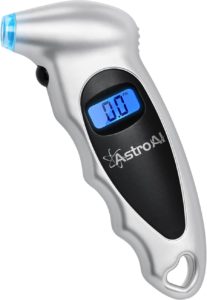The Audi A7 features a tire pressure monitoring system (TPMS) that assists drivers in maintaining the proper tire pressure for their vehicle. With its indirect TPMS, the Audi A7 monitors tire pressure in a different way than most systems. Instead of relying on individual sensors within each tire, it utilizes the car’s anti-lock braking system (ABS) to track pressure changes. By examining the rotation speeds of each wheel, the tire pressure system can detect variations that may indicate a change in tire pressure. If the TPMS identifies a potential issue it activates a warning light on the dashboard. (A yellow exclamation point) This prompts the driver to check the tires and adjust the pressure as needed. This ingenious approach allows for seamless tire pressure monitoring without the need for extra hardware or battery-powered sensors.
How Does the Audi A7 TPMS Work?
Indirect TPMS: Uses ABS and wheel speed to monitor tire pressure.
ABS Sensors: Track the rotational speed of each wheel.
Tire Pressure and Wheel Speed: Decreased pressure affects rolling diameter and rotational speed.
Algorithm Analysis: Calculates differences between wheel speeds to detect variations in tire pressure.
Warning Light: Alerts driver of potential tire pressure issues.
Driver Inspection: Prompted to check tires and adjust pressure as needed.
Seamless Monitoring: No need for additional hardware or battery-powered sensors.
Simplified Maintenance: Indirect TPMS ensures optimal tire performance with less maintenance required.
How to Reset Audi A7 TPMS?
Be sure to fill your tires to the correct PSI prior to following this procedure. Find the correct PSI on the inside of the driver-side door jamb.
Turn the ignition key to the “On” position or have the vehicle running.
Select Home and then Vehicle
Select Settings & Service
Select Tire Pressure Monitor
Select “Store Tire Pressure” and then “Yes, Store Now”
Car will confirm with “The current tire pressure has been stored”
Audi recommends driving the vehicle for at least 20 minutes at speeds above 12 mph to allow the system to recalibrate fully.
When to Reset the Audi A7 TPMS:
Tire Pressure Adjustment: If tire pressure has been adjusted due to changes in load or driving conditions, resetting the TPMS can help maintain accurate monitoring.
Tire Rotation: Reset the indirect TPMS after rotating the tires to ensure accurate monitoring of the new tire positions.
Tire Replacement: When replacing one or more tires on the vehicle, it’s essential to reset the TPMS to maintain accurate pressure monitoring.
Seasonal Tire Change: When switching between summer and winter tires, reset the indirect TPMS to account for the different tire types.
TPMS Malfunction Indicator: If the TPMS malfunction indicator light illuminates on the dashboard, resetting the system may resolve the issue after diagnosing and repairing any detected problems.
After Inflation: If the tire pressure light comes on due to low pressure and the tires have been inflated to the recommended level, reset the TPMS to clear the warning.
Wheel Alignment or Balancing: After performing wheel alignment or balancing services, reset the TPMS to ensure accurate tire pressure monitoring.
ABS Sensor Replacement: Since the indirect TPMS relies on data from the ABS, it’s important to reset the system after replacing an ABS or wheel speed sensor to maintain accurate pressure monitoring.
TPMS Software Update: If the vehicle’s TPMS software has been updated, reset the system to ensure proper functionality with the latest software version.
Vehicle Battery Replacement: After replacing the vehicle’s battery or jump starting a dead battery, resetting the TPMS may be necessary to re-establish proper communication between the system and the vehicle’s onboard computer.
What are Common Causes for Tire Pressure Lights to Turn On?
Low Tire Pressure: Natural pressure loss over time or temperature fluctuations can cause the tire pressure to drop, triggering the warning light.
Tire Puncture or Leak: A puncture or leak caused by a sharp object or road debris can lead to a pressure loss, activating the warning light. Audi A7’s have high performance wheels and low profile tires which are prone to rim cracks.
Mismatched Tire Sizes: If the tires on the vehicle have different sizes or are not of the same type, it can cause discrepancies in wheel rotation speeds. This can cause the indirect TPMS to falsely detect a pressure issue. We recommend always using OEM size tires.
Uneven Tire Wear: Tires with uneven wear can have different rolling diameters, causing variations in wheel speed that may trigger the tire pressure light.
Tire Rotation or Replacement: If the TPMS has not been reset after tire rotation or replacement, it may not accurately detect tire pressure changes. This can lead to a false tire warning light.
Wheel Alignment Issues: Poor wheel alignment can cause variations in tire rotation speeds, which can be misinterpreted by the indirect TPMS as a pressure issue.
Malfunctioning ABS Sensor: Since the indirect TPMS relies on data from the anti-lock brake system, a faulty ABS wheel speed sensor can cause inaccurate tire pressure readings and trigger the warning light.
TPMS Software Issues: Problems with the TPMS software or firmware can lead to false warnings, causing the tire pressure light to turn on even when tire pressures are within the recommended range. If you think this is the problem, use a manual tire pressure gauge to check tire pressures.
Tire Pressure Variation: If the tire pressure in one tire differs significantly from the others, it may cause the indirect TPMS to detect an issue and trigger the warning light.
Vehicle Weight Overload: When a vehicle is overloaded, the added weight can cause increased strain on the tires. This may lead to a change in the tire’s rolling diameter affecting the rotational speed of the wheels. As a result, the system might interpret the change in wheel speeds as a potential tire pressure issue and trigger a warning.
What Happens When Tires are Underinflated?
When tires are underinflated, it can lead to various issues that affect vehicle safety, performance, and fuel efficiency. Driving on underinflated tires can cause uneven tire wear, resulting in a shorter tire lifespan and potential handling and braking problems. Also, underinflated tires have an increased rolling resistance. This puts extra strain on the engine, leading to higher fuel consumption and emissions. Additionally, underinflated tires are more susceptible to heat buildup. This will cause the tire’s structural integrity to weaken and increase the risk of a blowout or tire failure. In conclusion, ensuring your tires are properly inflated is essential for maintaining optimal vehicle performance.
Please note that this blog post contains Amazon affiliate links. This means that if you make a purchase through one of these links, the author of the blog may earn a small commission at no extra cost to you. The author only recommends products that they personally use and believe in. Thank you for supporting this blog.



